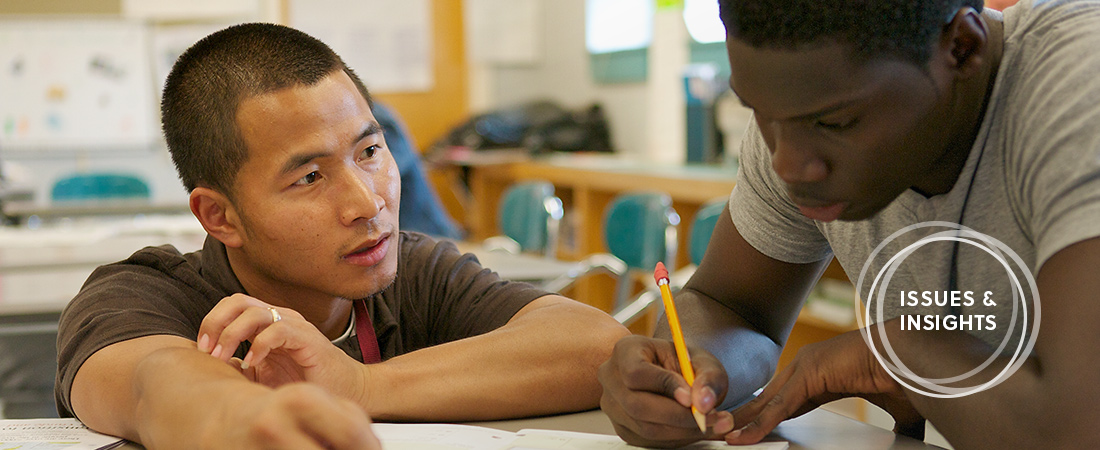Improving the Teaching of Teachers

"Teacher candidates benefit from experiences in a wide range of classrooms with diverse students," says EDC’s Karen Shakman.
Before new teachers ever set foot in a school, they must first gain the knowledge and skills to be successful in the classroom. For most teachers, this means attending a university-based teacher preparation program. In 2013, nearly 500,000 individuals were enrolled in teacher preparation programs in the United States.
Yet education policymakers are concerned. At a time when the total number of students in public schools is growing, enrollment in teacher preparation programs is on the decline. In addition, while more than half of all public school students are students of color, teacher education programs still mostly attract white female candidates.
A former teacher, EDC’s Karen Shakman studies teacher preparation in New England, with a focus on how programs can better recruit and retain educators of color, as well as teachers from rural communities. In this Q&A, she discusses some of the challenges facing teacher preparation programs and offers some insights into new ways forward.
Q: Why are you interested in the issue of teacher preparation?
Shakman: I used to teach, and I went through a teacher preparation program. But I remember feeling somewhat unprepared for the realities of the classroom. I did my student teaching at Springfield Central High School in Massachusetts. It was a working-class community, and most of my students worked many hours outside of school. One day, I was teaching Woodrow Wilson’s Fourteen Points. A student raised her hand and asked, “Why do we have to know this?” I had no good answer for her. I really didn't know how to make the case that this content was relevant to her life.
When I reflect on that experience now, I wonder how teacher preparation programs can help prepare teacher candidates to teach in ways that are both relevant and rigorous. That is no small task, and teacher preparation programs have to help future educators to be ready philosophically, socially, and emotionally to do the work of teaching. I’m interested in what it takes to do that well.
"Teacher preparation programs have to help future educators to be ready philosophically, socially, and emotionally to do the work of teaching."
–Karen Shakman
Q: Teacher preparation is a big topic in New England right now. Why is that?
Shakman: Over the last decade at least, and in some part due to the changes to the teacher evaluation systems in many states, educators and policymakers have raised questions about how teacher preparation programs are helping pre-service teachers meet the demands of professional practice. I think a lot of the current interest in teacher preparation programs stems from a genuine desire to improve these programs, so that teachers are better able to succeed when they enter the classroom. And there’s also a recognition that, while it’s important to evaluate teachers, it’s even more important to prepare them well in the first place.
Q: You are currently examining diversity and equity in teacher preparation programs. Why?
Shakman: There is a disconnect between the experiences of people who go into teaching—their experiences of race and class privilege in this country, and their own experiences in school—and the experiences of the students they teach. About 82 percent of teachers in this country are white, but 54 percent of their students are students of color. That’s a fundamental issue that the nation has to grapple with. Conversations about diversity and equity in teacher preparation programs force us to confront this reality and help us figure out how to recruit and retain teachers who are able to understand the diversity that our children bring to school.
Q: How are teacher preparation programs addressing this disparity?
Shakman: There are many interesting initiatives underway in New England. For example, the University of New Hampshire is running a rural teacher residency program that is focused on recruiting and training local educators to teach in some of the state’s most rural and remote schools. These schools often have a hard time finding teachers who are qualified and who understand the needs of rural students.
In Massachusetts, the Boston Public Schools is working hard to recruit and retain teachers that reflect the diversity of its students. The district actively recruits candidates of color to apply, and then runs programs to help train and retain these teachers after they have been hired. These efforts have paid off: 37 percent of teachers in the district are teachers of color.
And across the region, there’s a greater effort to promote diversity and cultural competence than in the past. For example, Connecticut now requires pre-service teachers to do their student teaching in either a high-need district or an economically or racially diverse district. So I think there’s a recognition that teacher candidates benefit from experiences in a wide range of classrooms with diverse students. That’s good for everyone.
